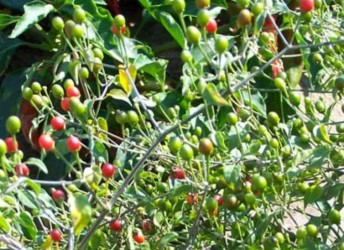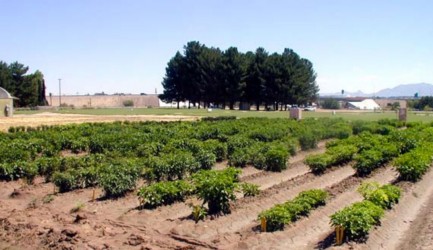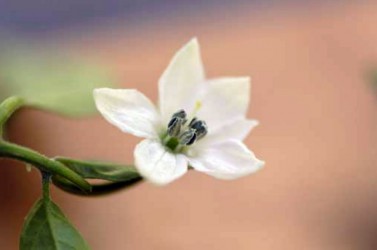Growing Tips
Classifying Capsicums
Chiles are perennial sub shrubs, native to South America, grown as annuals where freezing occurs. There are only a couple of places in the continental US that chiles can be grown as perennials: southern California, Florida, a very small portion of South Texas and a small area of southern Arizona. Chiles are not related to black pepper; however they are a part of the large nightshade family, which includes tomato, potato and eggplant. There are 5 domesticated species of chiles: Capsicum annuum which includes bells, New Mexicans, serrano’s, jalapeños and piquins, Capsicum chinense which includes habaneros and the infamous ‘Datil’, Capsicum frutescens, which includes Tabasco® and the original ‘Malagueta’, Capsicum baccatum, which includes the ‘Christmas Bell’ and true ajis, and Capsicum pubescens, which includes rocotos and manzanos.

The Origin and Spread of Chiles
Chiles are believed to have originated in an area bordered by the mountains of Brazil, and Bolivia in South America. Over thousands of years chiles ‘migrated’ out of this area with the help of birds and natives and eventually spread across the Americas. The ancient wild chiles had small, round, erect, bright red fruits that made them very attractive to birds, and birds are unable to feel the pungency associated with capsaicin. It is believed this evolved in this way because a bird’s digestive system does not harm seeds while a mammal does.
Preparing Your Garden
There is an overwhelming amount of chile pepper varieties available to the gardener. Many seed companies claim that all varieties grow well everywhere, this is not true. New Mexican varieties grow better in the southwest while bells and habaneros do not grow as well and grow better in other, more humid regions.

Garden Design – Some choices for growing chiles include:
– Ridges & Furrows (shown here)
– Flat Beds Raised Beds
– Sunken Beds Containers
One key to growing chiles successfully is adding compost; this improves workability, water-holding capacity, drainage, and fertility. Even under optimal conditions the germination process can be slow and irregular. Chile seeds need warmth, oxygen, and moisture to germinate. Higher germinations rates occur between 70 & 80 degrees F, while faster germination occurs between 90 & 100 degrees F. Soaking seeds for 2-3 days can also aid in the speed of germination.
Fertility: Most gardeners can grow great chiles by simply adding compost and aged manure to their existing soil conditions, of course you have to manipulate the soil if it is excessively sandy or clay. Chiles are usually considered to be a self-pollinating crop, however, within species, will readily cross-pollinate. If you’re planning to save seed take measures to protect your plants from cross-pollination.
Project Conclusion
Flower and fruit development, the key to flower set is nighttime temperature, which ideally should be between 65 and 80 degrees. Fruit set is enhanced by increased sunlight, however fruit will not set when night temperatures are above 86 degrees F. Some varieties will take 130 days or more to complete maturation. New Mexican pods ripening at temperatures between 86 & 95 degrees F have twice as many capsaicinoids as pods ripening between 59 & 72 degrees F.

Helpful Hints:
- Select early maturing varieties.
- Start seed indoors 8 to 10 weeks before the last expected frost.
- Before transplanting to a garden, “harden off” your seedlings by exposing them to outdoor
- temperatures (not freezing) for increasingly longer periods of time each day.
- Transplant when daytime temperatures average 70 degrees F and nighttime are around 55 degrees.
- Soil pH should be 6.5 and use of a balanced fertilizer is recommended (5-10-5 or 10-10-10.) Go easy on the Nitrogen.)
- Water during dry spells, at least 2 inches a week, especially after fruit set.
Publication from the Chile Pepper Institute, New Mexico State University
© Copyright 2006, all rights reserved